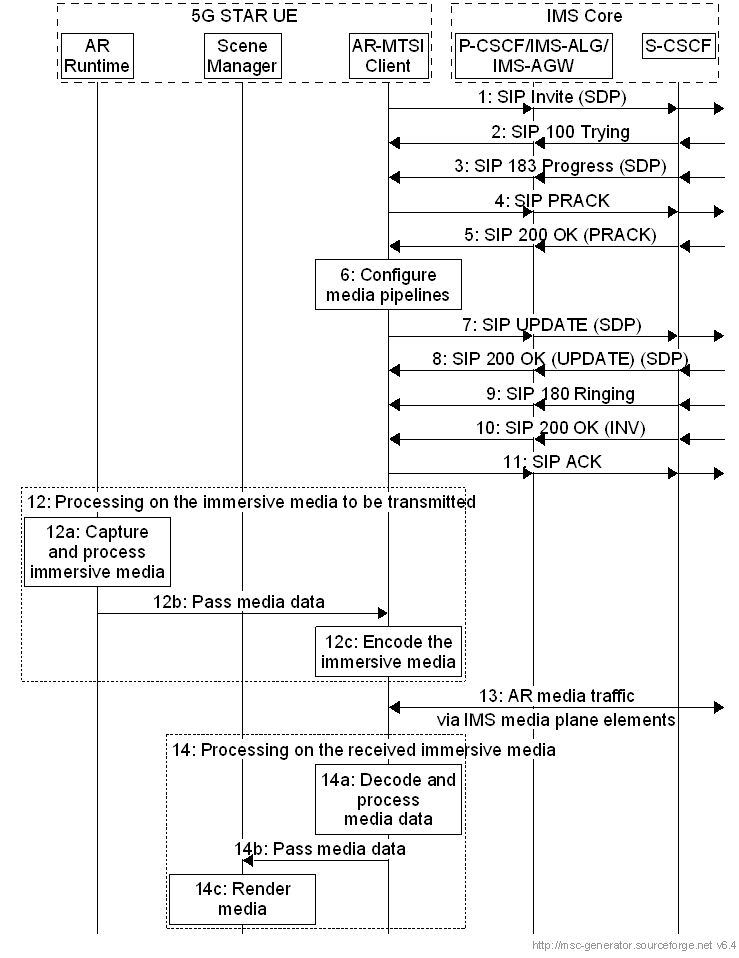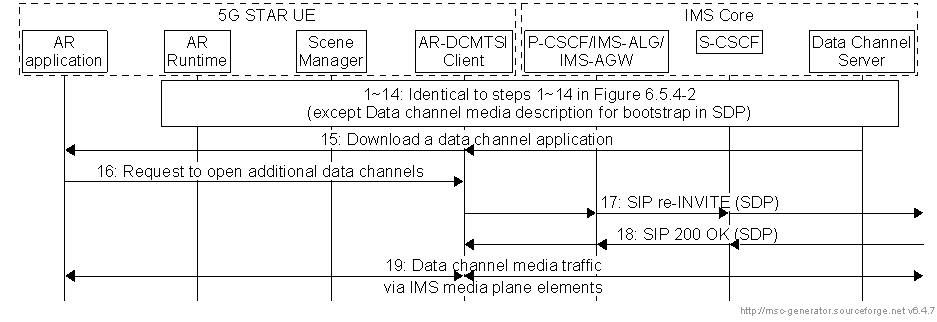Content for TR 26.998 Word version: 18.1.0
0…
4…
4.2…
4.2.2…
4.2.2.2
4.2.2.3
4.2.2.4
4.2.3…
4.3…
4.4…
4.5…
4.6…
4.6.4…
4.6.5…
4.6.8…
5
6…
6.2…
6.2.4…
6.2.4.2
6.2.5…
6.3…
6.3.4…
6.3.4.2
6.3.5…
6.4…
6.4.4
6.4.5…
6.5…
6.5.4
6.5.5
6.5.6…
6.6…
6.6.4
6.6.5…
7…
8…
8.9
9
A…
A.2
A.3…
A.4
A.5
A.6
A.7…
6.5.4 Instantiation #1: MTSI-based architecture extension p. 80
This instantiation provides the detailed architecture and procedures for the case of extending the current MTSI architecture. Figure 6.5.4-1 provides an MTSI-based architecture of conversational services for STAR UE.
An MTSI client specified in TS 26.114 may be extended to an AR-MTSI client which supports AR immersive media and take a role of Media Access Functions. A data channel application, an HTML web page including JavaScript(s) provided by a data channel server through a bootstrap data channel, also may be used to provide rich user experiences such as sitting side by side on a bench. Support of data channel media is optional for an MTSI client. An AR-MTSI client supporting data channel is denoted as an AR-DCMTSI client. Note that the data channel server may be implemented in IMS core or outside of it.

Figure 6.5.4-1: MTSI-based conversational service architecture for STAR UE
(⇒ copy of original 3GPP image)
(⇒ copy of original 3GPP image)
Figure 6.5.4-2 illustrates the procedure diagram for an immersive AR two party call using STAR UEs including an AR-MTSI client.

Figure 6.5.4-2: AR-MTSI client to AR-MTSI client call establishment (STAR UE)
(⇒ copy of original 3GPP image)
(⇒ copy of original 3GPP image)
Assumptions:
- AR immersive media is sent over RTP/UDP/IP.
- AR immersive media format (e.g. point clouds, triangular/polygon meshes) is negotiated and configured using SDP.
Step 1.
Figure 6.5.4-3 illustrates the procedure diagram for an immersive AR two party call using STAR UEs including an AR-DCMTSI client.
A STAR UE initiates a SIP INVITE request, containing the SDP offer with AR media capabilities.
Step 2.
The call propagates to the terminating STAR UE.
Step 3.
The called party's STAR UE returns an SDP answer in a SIP 183 progress message. The P-CSCF uses the SDP answer to allocate the required resources.
Step 4.
The originating STAR UE generate a PRACK which is transited to the terminating side of the call.
Step 5.
The originating STAR UE receives an associated 200 OK (PRACK).
Step 6.
The STAR UE reserves internal resources to reflect the SDP answer and configures media pipelines.
Step 7.
The STAR UE sends a SIP UPDATE message with a new SDP offer confirming the selected media parameters.
Step 8.
The 200 OK (UPDATE) response is received for the terminating STAR UE containing the SDP answer.
Step 9.
The terminating STAR UE is now alerted and sends a SIP 180 Ringing response.
Step 10.
When the called party's STAR UE has answered the call, it sends a 200 OK to the calling party STAR UE.
Step 11.
The STAR UE receives the 200 OK, and sends a SIP ACK message to acknowledge that the call has been established.
Step 12.
The STAR UE processes the immersive media to be transmitted.
Step 13.
- The AR runtime function captures and processes the immersive media to be sent.
- The AR runtime function passes the immersive media data to the AR-MTSI client.
- The AR-MTSI client encodes the immersive media to be sent to the called party's STAR UE.
The STAR UE has an AR call established with AR media traffic.
Step 14.
The STAR UE processes the received immersive media.
- The AR-MTSI client decodes and process the received immersive media.
- The AR-MTSI client passes the immersive media data to the Scene Manager.
- The Scene Manager renders the immersive media, which includes the registration of the AR content into the real world accordingly.

Figure 6.5.4-3: AR-DCMTSI client to AR-DCMTSI client call establishment (STAR UE)
(⇒ copy of original 3GPP image)
(⇒ copy of original 3GPP image)
Assumptions:
- AR immersive media is sent over RTP/UDP/IP.
- AR immersive media is negotiated and configured using SDP.
- A data channel application provides rich user experiences by utilizing both user's underlying scene and pose of objects representing users in the scene.
Step 1-14.
Same as the procedures for AR-MTSI client to AR-MTSI client call establishment except that the SDP contains a data channel media description for the bootstrap data channel.
Step 15.
The STAR UE retrieve a data channel application through the bootstrap data channel.
Step 16.
Any additional data channels created and used by the data channel application itself are requested.
Step 17.
The AR-DCMTSI client initiate SIP re-INVITE request, containing an updated SDP offer to establish those data channels.
Step 18.
The data channels for the data channel application has been established.
Step 19.
The established data channel may be used by the data channel application JavaScript(s).